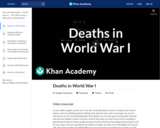
Deaths in World War I
- Subject:
- History
- Material Type:
- Lesson
- Provider:
- Khan Academy
- Provider Set:
- Khan Academy
- Author:
- Sal Khan
- Date Added:
- 07/26/2021

Deaths in World War I
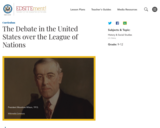
American foreign policy continues to resonate with the issues surrounding the debate over U.S. entry into the League of Nations-collective security versus national sovereignty, idealism versus pragmatism, the responsibilities of powerful nations, the use of force to accomplish idealistic goals, the idea of America. Understanding the debate over the League and the consequences of its ultimate failure provides insight into international affairs in the years since the end of the Great War.

This video segment, adapted from Decision in the Streets by civil rights filmmaker Harvey Richards, portrays the interracial protests that took place in San Francisco in 1963-64.
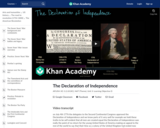
"We hold these truths to be self-evident, that all men are created equal . . . " In this video, Kim explores the origins of the Declaration of Independence in the ideas of Enlightenment philosopher John Locke and its resounding message in history.
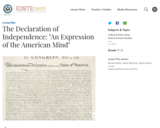
This lesson plan looks at the major ideas in the Declaration of Independence, their origins, the Americans' key grievances against the King and Parliament, their assertion of sovereignty, and the Declaration's process of revision.
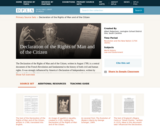
This collection uses primary sources to explore the Declaration of the Rights of Man and of the Citizen. Digital Public Library of America Primary Source Sets are designed to help students develop their critical thinking skills and draw diverse material from libraries, archives, and museums across the United States. Each set includes an overview, ten to fifteen primary sources, links to related resources, and a teaching guide. These sets were created and reviewed by the teachers on the DPLA's Education Advisory Committee.

Teaching multicultural literature is happily a big part of the modern conversation about English classes. However, a question that is less often asked is, what is the root of the need for it? Many Americans shuffle about their lives oblivious to the structural racism that permeates much of our society and culture. Those who choose “not to see color” or race are proliferating opportunities for a dominant culture to continue and even expand, thereby limiting opportunities for others. Through utilization of two important concepts – Critical Race Theory and Colorblind Racial Ideology – we can improve humanities instruction by scrutinizing the much bigger, and often ignored, picture of modern racism. Combining this with instruction on the art of Afrofuturism – specifically the work of Octavia Bulter, Sun Ra, and Jean Michel Basquiat among others – we can also fill a similar gap in the modern American imagination.

Americans elect a president through the state-by-state mechanism of the Electoral College rather than direct nationwide popular vote. Today, all but two states award all of their electoral votes to the statewide winner.

In a series of three brief clips, Larry Kramer, Dean of Stanford Law School, provides some insights into understanding and teaching various details of the constitution.

In all, 70 delegates were appointed to the Constitutional Convention, but out of that 70 only 55 attended, and only 39 actually signed. Some simply refused, others got sick, still others left early.

The U.S. Constitution Pathway delves into the Constitution's past and its lasting principles, highlighting their relevance to modern-day issues and events. Through the lens of history and social science, students engage in a critical exploration of how the values of freedom, justice, and equality play out in today's complex world. The pathway culminates in the Civic Action Project, which allows students to apply their learning and impact a public issue that matters to them. Access to these resources require a free educator login.

The website ‘The West Indian Heritage’ tells its story using the buildings as a framework for understanding the structure, function, and people of the colony who were either forced to risk their lives producing the coveted goods or benefited from the profits on the goods throughout the first 150 years of the colony’s history.
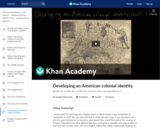
How British were the British colonies in North America in 1754? In this video, Kim discusses how the British colonies participated in political, social, cultural, and economic exchanges with Great Britain that encouraged both stronger bonds with Britain and resistance to Britain’s control.
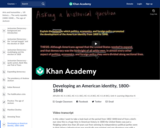
From 1800 to 1848, the United States grew tremendously as a country, adding new territory and building national connections of business and transportation. But just twelve years later, the Civil War erupted! In this period, was the United States developing a unified national identity or a divided regional identity?
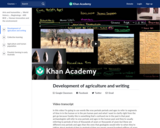
The Paleolithic and Neolithic eras of the Stone Age. Created by Sal Khan.
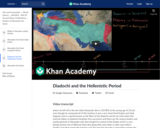
Alexander's Empire fragments into Seleucid Persia, Ptolemaic Egypt and Antigonid Macedonia (and other kingdoms) and gives rise to the Hellenistic Period.
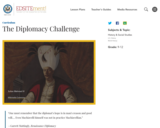
During the Early Modern era (1450"“1750), the expansion in maritime trade and the incorporation of the Americas into worldwide exchanges meant the world became increasingly interconnected. These connections led to a greater need for diplomatic relations with other states. Like many modern institutions, diplomacy as we know it today had its origins during this period.
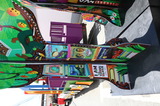
The resources shared here align to the Virgin Islands Department of Education State Literacy Plan. With a focus on literacy as a shared responsibilty, these customized roadmaps offer strategies for integrating literacy in Mathematics, Science, History, the Arts, and the Health & Phyiscal Education classrooms.

Docs Teach is the online tool for teaching with documents, from the National Archives.
* Choose from thousands of primary sources for use in classroom activities.
* Find and use activities crafted by educators using documents from the National Archives.
* Create your own interactive learning activities.

The purpose of this lesson is to assist student exploration of several of the primary source documents related to the creation of the executive branch. Through independent reading followed by a round robin assignment and an essay to explore current application of executive power, students will develop their historical inquiry skills and understand the scope and meaning of executive power under the U.S. Constitution.